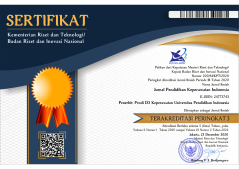Understanding Nurses Experiences and Perception about The Implemention of Emergency Monitoring : A Qualitative Study
Abstract
ABSTRACT
Emergency monitoring in the hospital is very important to be carried out, as one form of responsibility for early detection of deterioration patients. The implementation of the Early Warning System in Hospital is still being evaluated by the quality of service to find out its effectiveness. The purpose of this study was to explore the experiences and perceptions of nurses about the implementation of emergency monitoring in hospital. This study was a qualitative design. Participants were 6 female team leader nurses, with average age 35.3 y.o, and average working experience 11.3 years, used purposive sampling. Data were collected by in-depth interviews and field notes. Data were analyzed using thematic analysis method by Flick. The findings of the study identified 3 themes: (1) personal themes; (2) environmental themes; (3) Patient themes. The results showed that the implementation of emergency monitoring in the inpatients units in hospital was still not optimal. The implementation of the Early Warning System is expected to be carried out on an ongoing basis so that its implementation is effective. Socialization, training, supervision, and adequate infrastructure are needed as well as consistency algorithms for early identification of the patient's condition and getting immediate assistance.
ABSTRAK
Pemantauan kedaruratan di rumah sakit sangat penting dilakukan, sebagai salah satu bentuk tanggung jawab untuk deteksi dini kemunduran pasien. Penerapan Sistem Peringatan Dini di Rumah Sakit masih terus dievaluasi kualitas pelayanannya untuk mengetahui efektivitasnya. Penelitian ini bertujuan untuk mengetahui pengalaman dan persepsi perawat tentang pelaksanaan pemantauan kegawatdaruratan di rumah sakit. Penelitian ini merupakan penelitian kualitatif. Peserta penelitian adalah 6 perawat ketua tim wanita, dengan usia rata-rata 35,3 tahun, dan pengalaman kerja rata-rata 11,3 tahun, menggunakan purposive sampling. Pengumpulan data dilakukan dengan wawancara mendalam dan catatan lapangan. Data dianalisis menggunakan metode analisis tematik oleh Flick. Temuan penelitian mengidentifikasi 3 tema: (1) tema pribadi; (2) tema lingkungan; (3) Tema pasien. Kesimpulan: Hasil penelitian menunjukkan bahwa pelaksanaan pemantauan kegawatdaruratan di unit rawat inap rumah sakit masih belum optimal. Penerapan Sistem Peringatan Dini diharapkan dapat dilakukan secara berkesinambungan agar pelaksanaannya efektif. Dibutuhkan sosialisasi, pelatihan, supervisi, dan infrastruktur yang memadai serta konsistensi algoritme untuk identifikasi awal kondisi pasien dan mendapatkan bantuan segera.
Keywords
Full Text:
PDFReferences
Afiyanti, Y., & Rachmawati, I. N. (2019). Metodologi penelitian kualitatif dalam riset keperawatan (1st ed.). Jakarta: Raja Grafindo Persada.
Alam, N., Hobbelink, E. L., van Tienhoven, A.-J., van de Ven, P. M., Jansma, E. P., & Nanayakkara, P. W. B. (2014). The impact of the use of the Early Warning Score (EWS) on patient outcomes: a systematic review. Resuscitation, 85(5), 587–594.
Berkow, S., Virkstis, K., Stewart, J., & Conway, L. (2008). Assessing new graduate nurse performance. JONA: The Journal of Nursing Administration, 38(11), 468–474.
Chua, W. L., Mackey, S., Ng, E. K. C., & Liaw, S. Y. (2013). Front line nurses’ experiences with deteriorating ward patients: a qualitative study. International Nursing Review, 60(4), 501–509.
Creswell, J. W., & Poth, C. N. (2016). Qualitative inquiry and research design: Choosing among five approaches. Sage publications.
Firmansyah, C. S., Noprianty, R., & Karana, I. (2019). Perilaku Caring Perawat Berdasarkan Teori Jean Watson di Ruang Rawat Inap. Jurnal Kesehatan Vokasional, 4(1), 33–48.
Flick, U. (2018). An introduction to qualitative research. Sage Publications Limited.
Friesen, M. A., Farquhar, M. B., & Hughes, R. (2005). The nurse’s role in promoting a culture of safety: American Nurses Association Continuing Education. Center for American Nurses.
Hogan, H., Healey, F., Neale, G., Thomson, R., Vincent, C., & Black, N. (2012). Preventable deaths due to problems in care in English acute hospitals : a retrospective case record review study, 737–745. https://doi.org/10.1136/bmjqs-2011-001159
Irland, N. B. (2012). A Physiologically-Based Early Warning Score for Postpartum Patients: Does it Equalize the Decision-Making of RNs Along the Novice-to-Expert Continuum? Scholar Archive, 908.
Keene, C. M., Kong, V. Y., Clarke, D. L., & Brysiewicz, P. (2017). The effect of the quality of vital sign recording on clinical decision making in a regional acute care trauma ward. Chinese Journal of Traumatology, 20(5), 283–287.
Leonard, M. M., & Kyriacos, U. (2015). Student nurses’ recognition of early signs of abnormal vital sign recordings. Nurse Education Today, 35(9), e11–e18.
Manoj, B. S., & Baker, A. H. (2007). Communication challenges in emergency response. Communications of the ACM, 50(3), 51–53.
Manurung, D. R. (2018). Gambaran tingkat pengetahuan perawat dalam penerapan early warning score di ruang perawatan lantai 2, 5 dan 6 rumah sakit siloam dhirga surya= description of nursing knowledge level in the application of ews in the treatment rooms of 2nd, 5th and 6th floo. Universitas Pelita Harapan.
Massey, D., Chaboyer, W., & Anderson, V. (2017). What factors influence ward nurses’ recognition of and response to patient deterioration? An integrative review of the literature. Nursing Open, 4(1), 6–23.
Nowell, L. S., Norris, J. M., White, D. E., & Moules, N. J. (2017). Thematic Analysis: Striving to Meet the Trustworthiness Criteria. International Journal of Qualitative Methods, 16(1), 1–13. https://doi.org/10.1177/1609406917733847
Pantazopoulos, I., Tsoni, A., Kouskouni, E., Papadimitriou, L., Johnson, E. O., & Xanthos, T. (2012). Factors influencing nurses’ decisions to activate medical emergency teams. Journal of Clinical Nursing, 21(17‐18), 2668–2678.
Polit, D. F., & Beck, C. T. (2010). Generalization in quantitative and qualitative research: Myths and strategies. International Journal of Nursing Studies, 47(11), 1451–1458.
Saputro, A. H., & Zendrato, B. I. (2018). Gambaran penerapan pendokumentasian early warning system score pada pasien kanker di satu rumah sakit swasta Indonesia bagian barat= description of early warning system score application on patients in west Indonesia private hospital. Universitas Pelita Harapan.
Smith, M. E. B., Chiovaro, J. C., O’Neil, M., Kansagara, D., Quiñones, A. R., Freeman, M., … Slatore, C. G. (2014). Early warning system scores for clinical deterioration in hospitalized patients: a systematic review. Annals of the American Thoracic Society, 11(9), 1454–1465.
Stafseth, S. K., Grønbeck, S., Lien, T., Randen, I., & Lerdal, A. (2016). The experiences of nurses implementing the Modified Early Warning Score and a 24-hour on-call Mobile Intensive Care Nurse: An exploratory study. Intensive and Critical Care Nursing, 34, 33–41.
WHO. (2009). Global priorities for patient safety research.
Wood, M. J., & Ross-Kerr, J. (2010). Basic steps in planning nursing research: From question to proposal. Jones & Bartlett Publishers.
DOI: https://doi.org/10.17509/jpki.v6i2.25032
Refbacks
- There are currently no refbacks.
Jurnal Pendidikan Keperawatan Indonesia(JPKI) published by Indonesia University of Education. JPKI is licensed under a Creative Commons Attribution-ShareAlike 4.0 International License.
Office :
Nursing Department. FPOK UPI.
229, Dr. Setiabudhi Street. Bandung 40154
West Java , Indonesia
E-mail : jpki@upi.edu

_.png)
_.png)
_.png)











